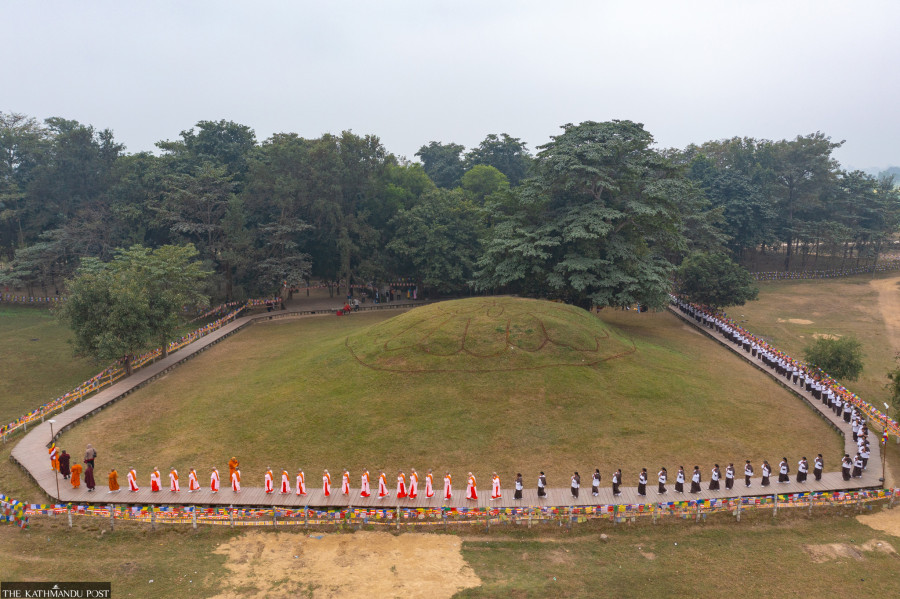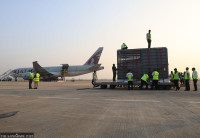Lumbini Province
Revered Ramgram Stupa is in the spotlight again
Ramgram is the only one among the eight relic stupas to be left untouched to respect its sanctity.
Manoj Paudel
Ramgram Stupa has drawn public attention after the Lumbini Development Trust (LDT) granted permission to two private companies to unearth the historical area and construct stupas, Vihars and other structures.
The Trust has agreed to lease out a total of 120 bigha (81.27 hectares) of land for 99 years to the Singapore-based Moksha Foundation and Nepal-based Promised Land. Of the total 120 bigha, 116 bigha (78.56 hectares) belongs to local residents and needs to be acquisitioned.
Recently, the vice-chairman of the Lumbini Development Trust, Lharkyal Lama, unilaterally decided to lease out the Ramgram area to the private companies ignoring written objections by the Ministry of Culture, Tourism and Civil Aviation, the Ministry of Finance and the Department of Archeology.
Against this backdrop, archaeologists have highlighted the significance of the Ramgram Stupa in Buddhism.
Ramgram Stupa is one of the eight original relic stupas where the corporeal remains of Gautam Buddha were enshrined. The stupa is a 7-metre high brick mound situated in ward 7 of Ramgram Municipality, around seven kilometres south of Parasi, the district headquarters of Nawalparasi West.
Some historians and archaeologists believe the ruins and artefacts date back to the Maurya era. Relics recovered during excavations in Ramgram and its surroundings suggest the area could have been the capital of the ancient Koliya state, the parental home of Buddha’s mother Mayadevi.
Lumbini in Rupandehi district is the birthplace of Siddhartha Gautam. He spent his princely life in Tilaurakot palace of Kapilvastu district while Ramgram Stupa is the revered relic stupa for Buddhists. This historic stupa lies on the bank of the Jharahi stream in the village of Ujjaini.
According to archaeologists and historians, Ramgram is the only stupa among the eight relic stupas to be left untouched to respect its sanctity.
Gautam Buddha, the Light of Asia, died in Kushinagar, India, at the age of 80. Kushinagar was then called Kushawati, the capital of Malla, which was one of the 16 Janapadas of the 6th century BCE.
According to Buddhist literature, seven rulers reached Kushinagar to bring the Asthidhatu (corporeal remains) of Lord Buddha. The Malla residents initially refused to give the remains, but they finally agreed to distribute the corporeal remains as per the suggestion of priest Drona. One of the Asthidhatus was brought and enshrined in Ramgram Stupa.
During his reign from 269 BCE to 232 BCE, Maurya emperor Ashoka opened seven relic stupas, took out the remains and built around 84,000 new stupas across the region. Ramgram Stupa is the only original relic stupa that was not opened by Ashoka. The Buddha literature says Ashoka had attempted to open Ramgram Stupa as well but Nags, the serpent gods, prevented him from doing so. Thus Ramgram Stupa is also known as the stupa of Nags.
Gautam Buddha was born in Lumbini, attained enlightenment in Bodhgaya, preached first in Sarnath, and died in Kushinagar. Ramgram is as important as these four places. “Ramgram is the only stupa where the Asthidhatu is still untouched. So visiting Ramgram is like visiting the Buddha. Many devotees dream of visiting this holy shrine,” said monk Sumangalo.
Chinese travellers Fa Hein in the 5th century and Hiuen Tsang in the 7th century mentioned Ramgram in their travel accounts. But the historical place was unknown for a long time.
Ramgram Stupa was first discovered in 1899 by W Hoey, a historian from the Asiatic Society of Bengal, before it was confirmed to be a stupa by SB Deo later in 1964. The Department of Archaeology of Nepal carried out an excavation of the mound in 1997. Adequate information about the history of the stupa has been brought to light by the five-year excavation.
According to archaeologist Basanta Bidari, various archaeologically important objects and structures dating back to the 6th century BCE were found during the recent excavation and study in Ramgram. “Ramgram is a holy place for Buddhist devotees and peace seekers,” he asserted.
A team of experts and archaeologists from the Durham University of the UK, the Department of Archeology and the Lumbini Development Trust conducted a geophysics survey to find out ancient structures at Ramgram in 2012.
“In the survey, the remnants of an ancient pond were found some distance from the northwest corner of the stupa. “Based on the geophysics survey, a fresh excavation was carried out in Ramgram last year. Structures of a pond and a Vihar (monastery), believed to have been built during the Buddha era (around the 5th century BCE), were uncovered during the excavation of the historical site,” said Himal Uprety, chief at the archaeology department of the Lumbini Development Trust.
Government authorities are working to include Ramgram Stupa on the Unesco World Heritage Sites list.




 18.12°C Kathmandu
18.12°C Kathmandu












%20(1).jpg&w=300&height=200)

